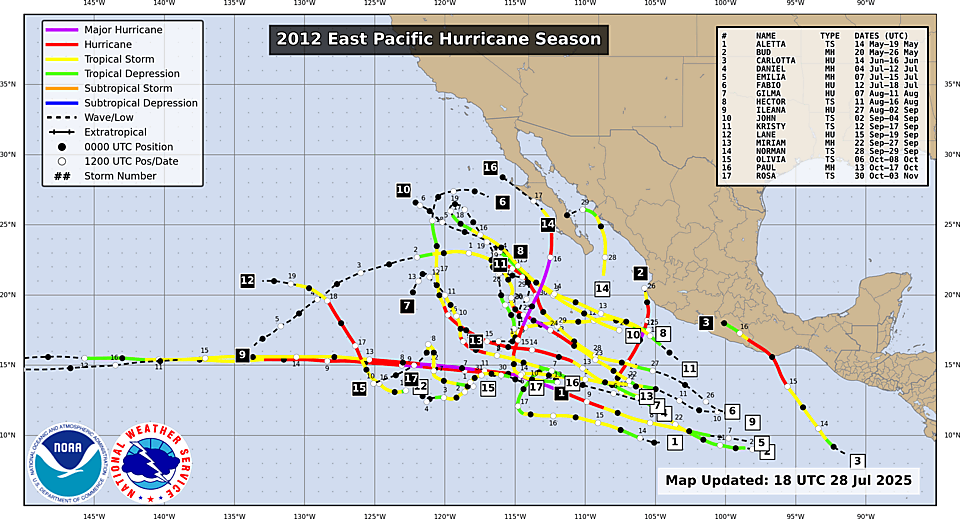2012 Eastern Pacific Hurricane Season
2011 | 2012 | 2013 | 2014 | 2015 | 2016 | 2017 | 2018 | 2019 | 2020 | 2021 | 2022 | 2023 | 2024 | 2025
The National Hurricane Center's Tropical Cyclone Reports contain comprehensive information on each tropical cyclone, including synoptic history, meteorological statistics, casualties and damages, and the post-analysis best track (six-hourly positions and intensities). Tropical cyclones include depressions, storms and hurricanes. Tropical depressions listed below are those that did not reach tropical storm strength.
XML index of all Tropical Cyclone Reports
- Tropical Storm Aletta – PDF – KMZ
- Hurricane Bud – PDF – KMZ
- Hurricane Carlotta – PDF – KMZ
- Hurricane Daniel – PDF – KMZ
- Hurricane Emilia – PDF – KMZ
- Hurricane Fabio – PDF – KMZ
- Hurricane Gilma – PDF – KMZ
- Tropical Storm Hector – PDF – KMZ
- Hurricane Ileana – PDF – KMZ
- Tropical Storm John – PDF – KMZ
- Tropical Storm Kristy – PDF – KMZ
- Hurricane Lane – PDF – KMZ
- Hurricane Miriam – PDF – KMZ
- Tropical Storm Norman – PDF – KMZ
- Tropical Storm Olivia – PDF – KMZ
- Hurricane Paul – PDF – KMZ
- Tropical Storm Rosa – PDF – KMZ
Season Summary
A brief overview of the hurricane season is available in the 2012 Eastern Pacific Annual Summary (PDF).
East Pacific Tropical Weather Summary (2012)

| Storm Number | Storm Name | Typea | Datesb (UTC) |
Max. Winds (kt) |
Min. Pressure (mb) |
Accumulated Cyclone Energyc (x104 kt2) |
Direct Deathsd |
U.S. Damagee ($million) |
Tropical Cyclone Report Status |
|---|---|---|---|---|---|---|---|---|---|
| 1 | Aletta | TS | 14 May–19 May | 45 | 1000 | 1.5 | |||
| 2 | Bud | MH | 20 May–26 May | 100 | 961 | 7.9 | |||
| 3 | Carlotta | HU | 14 Jun–16 Jun | 95 | 973 | 3.6 | |||
| 4 | Daniel | MH | 04 Jul–12 Jul | 100 | 961 | 11.5 | |||
| 5 | Emilia | MH | 07 Jul–15 Jul | 120 | 945 | 18.6 | |||
| 6 | Fabio | HU | 12 Jul–18 Jul | 95 | 966 | 10.7 | |||
| 7 | Gilma | HU | 07 Aug–11 Aug | 70 | 984 | 4.8 | |||
| 8 | Hector | TS | 11 Aug–16 Aug | 45 | 995 | 2.2 | |||
| 9 | Ileana | HU | 27 Aug–02 Sep | 75 | 978 | 7.0 | |||
| 10 | John | TS | 02 Sep–04 Sep | 40 | 1000 | 0.8 | |||
| 11 | Kristy | TS | 12 Sep–17 Sep | 50 | 998 | 3.1 | |||
| 12 | Lane | HU | 15 Sep–19 Sep | 75 | 985 | 4.4 | |||
| 13 | Miriam | MH | 22 Sep–27 Sep | 105 | 959 | 9.8 | |||
| 14 | Norman | TS | 28 Sep–29 Sep | 45 | 997 | 0.7 | |||
| 15 | Olivia | TS | 06 Oct–08 Oct | 50 | 997 | 1.9 | |||
| 16 | Paul | MH | 13 Oct–17 Oct | 105 | 959 | 7.1 | |||
| 17 | Rosa | TS | 30 Oct–03 Nov | 45 | 1001 | 2.7 |
| 2012 East Pacific Summary | |||||
|---|---|---|---|---|---|
| Named Storms
(vs 1991-2020 Normal) |
Hurricanes
(vs 1991-2020 Normal) |
Major Hurricanes
(vs 1991-2020 Normal) |
Total ACE (x104 kt2)
(% Difference of 1991-2020 Normal) |
Total Direct Deaths |
Total U.S. Damagee ($million) |
| 17 (+2) | 10 (+2) | 5 (+1) | 98.4 (-10% ) | 0 | 0 |
a Tropical depression (TD) or Subtropical Depression (SD), maximum sustained winds 33 kt or less; tropical storm (TS) or Subtropical Storm (SS), winds 34-63 kt; hurricane (HU), winds 64-95 kt; major hurricane (MH), winds 96 kt or higher.
b Dates begin at 0000 UTC and include all tropical and subtropical cyclone stages; non-tropical stages are excluded except for PTCs which have no tropical stages.
c Accumulated Cyclone Energy is an index that is defined as the sum of the squares of the maximum sustained surface wind speed (knots) measured every six hours for all named storms while they are at least tropical storm intensity. Note the ACE total in this table is only for the basin being summarized (e.g., 140°W–180° in the Central Pacific).
d Deaths occurring as a direct result of the forces of the tropical cyclone are referred to as “direct” deaths. These would include those persons who drowned in storm surge, rough seas, rip currents, and freshwater floods. Direct deaths also include casualties resulting from lightning and wind-related events (e.g., collapsing structures).
e U.S. damage totals are based on values provided by the NOAA National Centers for Environmental Information (NCEI).
Last updated: August 11, 2025
If you have trouble viewing linked files, obtain a free viewer for the file format:


